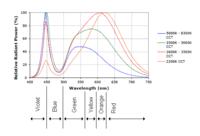T
treez
Guest
Hello,
This regards the fact that cree sells two different variants of the same LED, with vastly different brightness, but they are the same price.....why?.....surely the much brighter LED should be more expensive?
MX6AWT-A1-0000-0007EA = 67 lumens at 300mA
MX6AWT-A1-0000-000E51 = 114 lumens at 300mA
Tthis is seen on page 3 of the MX6 LED datasheet....
MX6 LED datasheet
**broken link removed**
if you type those part numbers into digikey.com, you can see that these LEDs are the same price.........so why would anyone ever buy the dimmer one if they are the same price?
This regards the fact that cree sells two different variants of the same LED, with vastly different brightness, but they are the same price.....why?.....surely the much brighter LED should be more expensive?
MX6AWT-A1-0000-0007EA = 67 lumens at 300mA
MX6AWT-A1-0000-000E51 = 114 lumens at 300mA
Tthis is seen on page 3 of the MX6 LED datasheet....
MX6 LED datasheet
**broken link removed**
if you type those part numbers into digikey.com, you can see that these LEDs are the same price.........so why would anyone ever buy the dimmer one if they are the same price?
